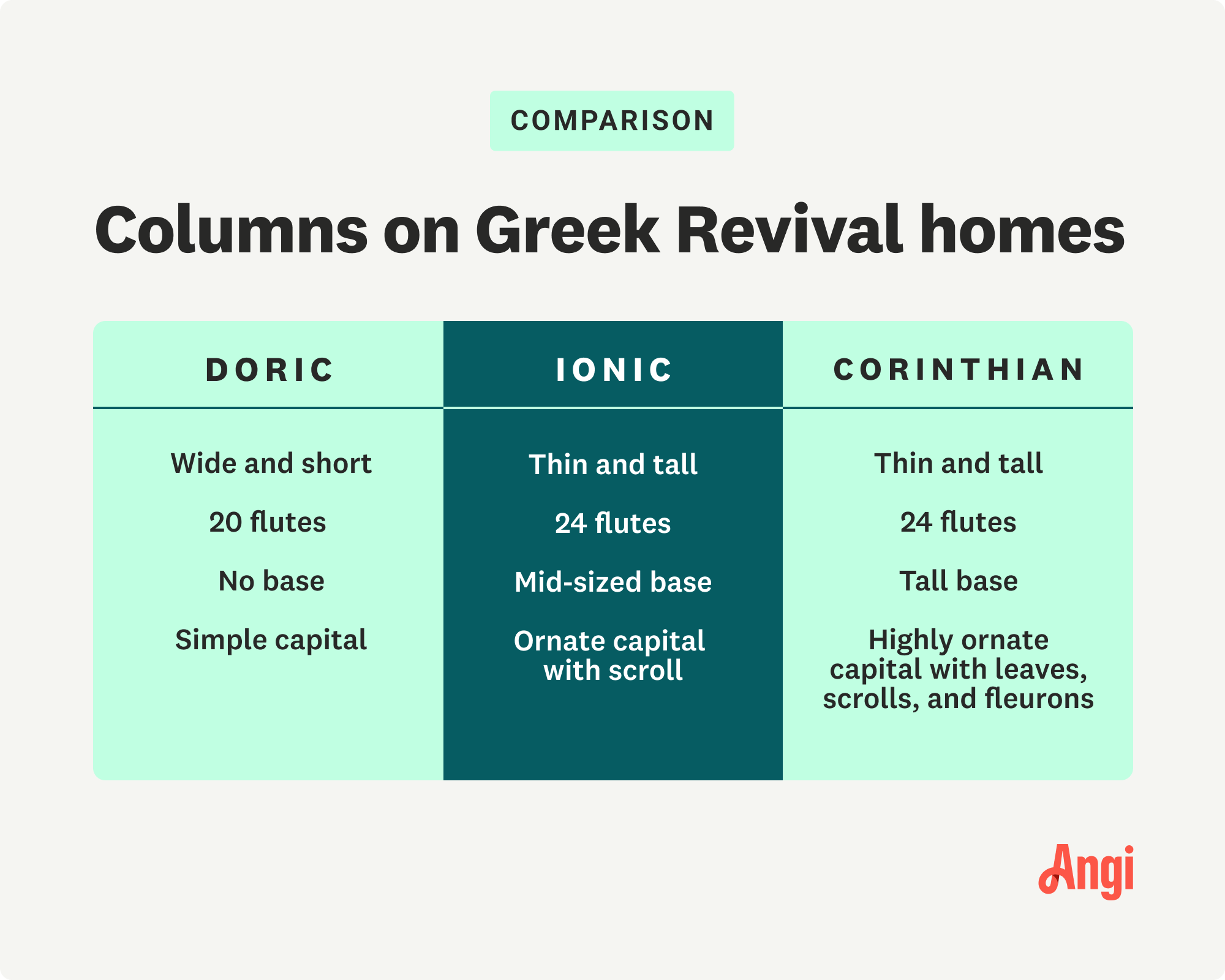
Need to know how much blueprints cost for your new construction project? Use this comprehensive cost guide to get an accurate estimate for your build.
From Athens, Greece to Athens, GA, this home style is where utilitarianism meets opulence


The Greek Revival architectural style took off from 1825–1860.
A societal passion for Greek culture, art, and democracy inspired the movement.
The design features a white facade, tall columns, and low-sloped roofs.
The style still represents opulence in homes across the country.
If you've ever driven past a home that looks a bit like the Parthenon, you've likely stumbled upon Greek Revival architecture. While it was a British architect who first developed the style for a more modern era, it made its way to the U.S. some years later, quickly replacing the early Colonial style and Federal architecture found across the colonies.
Curious about what makes a building a genuine Greek Revival? Let's dive in.
Take a moment to ponder the energy of the newly minted United States in the 1830s. Celebrating democracy was all the rage, and nothing represented the development of democracy more than the ancient Greeks. And so, styling your home in the Greek style was essentially a cultural and intellectual flex.
Greek Revival rose in the U.S. in reaction to the Georgian and Federalist-style homes—two styles that had too many British influences for the tastes of the time. The style launched on the east coast, primarily in significant buildings at the center of towns such as the libraries, banks, courts, and prominent homes. Greek Revivals then made their way down the coast to the South, along the gulf, and eventually to the West.
Greek Revival architecture became popular at a time when archaeologists were first uncovering ancient Greek buildings. American architects borrowed heavily from the design principles unearthed at the time to develop this style that dominated for decades.
When renovating historic homes, your HOA or local government may have specific laws or requirements. A contractor with experience remodeling historic or specialty homes can help navigate local red tape.
Greek Revival homes unmistakably resemble an ancient Greek temple. But you'll find the style in everything from towering town halls to small beachside homes with white-columned porches. Sandwiched between the Federalist home style of the early 19th century and highly ornate gothic revival during the Civil War, Greek Revival strikes a balance between grandiose and practical.
Much like the other neoclassical styles that came right before Greek Revival, these homes celebrate symmetry and equilibrium. Both the interior and the exterior of a Greek Revival building are incredibly similar, if not identical, from one end to the other. The porch, street-facing gable, and columns all mirror one another. Walk into the center foyer, and you'll likely find identical parlors on either side.
The symmetry is held in the number and type of windows, the shape and slope of the simple gabled roof, and even the number and positions of the chimneys. This is one way in which Greek Revival architecture differs from Italianate-style homes, which share some other similarities but not symmetry.
You'll notice pretty quickly that the facades—and often the original interiors—of Greek Revival homes are painted white, much like you find in Palm Springs architecture. The look aimed to portray the columns and walls of stone in a Greek temple. Instead of stone, however, American homes used wood covered in white plaster.
You will find all three of the most common Greek column styles on Greek Revival homes, though the simpler Doric and Ionic are the most common. Doric columns are wide, short, and stand without a base or an ornamental capital. Ionic columns feature both a base and a scroll-topped capital and are a bit thinner than Doric columns.
Corinthian columns have a highly decorated capital and are often only seen on more dramatic Greek Revival buildings—like the New York Stock Exchange building.

Regardless of the actual style, columns were a crucial part of capturing the ancient Greek architecture during the mid 19th century, so most homes of this style include them. The columns are what set this style apart from the more traditional Colonial architecture, and the more ornate columns are found on Greek Revival homes but not on the similarly symmetrical and simple Federal architecture homes.
Greek Revival homes almost always include a low-pitched, gabled roof. The gable faces the street with a wide, triangular pediment. The front gable sometimes featured an entablature—a trimmed pattern along the perimeter of the gable. Below the gable, you'll likely find cornice molding above a Frieze—the thicker horizontal layer that sits just below a cornice. The capitals of the columns will likely attach right to this layer as well.
The simple gabled roof helps establish the home’s symmetry and maintains a cleaner look than a hip roof or other roof style.
A grand entryway gave visitors that unmistakable feeling of grandeur when they walked into a Greek Revival building. A few steps led up to a symmetrical porch that stretched across the front of the building. More opulent homes featured two-story porches, if not a two-story portico above the front door.
Original Greek Revival homes included floor-to-ceiling, double-hung windows with multiple panes. On the second floor, you'll likely find smaller rectangular windows just below the gable.
Decorative windows also flanked the front door and were typically broken into three sections instead of two. Designers included delicate ornamentation around the outside of both windows and doors, but the front entryway received the most attention.
Again, the windows helped to maintain the symmetry that defines this style.
Greek Revival homes are antiquated, but the old-world charm they embody still makes them a popular choice among some homeowners. As with other styles, there are some significant upsides and drawbacks to living with Greek Revival architecture.
There are some unmistakable benefits to living in a Greek Revival home:
Relatively easy to maintain: Greek Revival architecture involves clean lines that tend to be easier to maintain than homes with more complex roofs, curved walls, or multiple dormers or bump-outs. These homes aren’t the most affordable to maintain, but some DIY maintenance will be more straightforward.
Dripping with charm: One of the biggest benefits to Greek Revival architecture is that it’s charming, and it harkens back to ancient design principles. Provided it’s not out of place in your area, the old-world charm this style provides is astounding.
Visually appealing: With clean lines, perfect symmetry, and a touch of opulence, Greek Revival architecture will appeal to just about anyone, even if they aren’t particularly fond of the old-world style.
Of course, there are some downsides to choosing a Greek Revival home, as well:
Can be expensive to repair: Many homes from this era are protected as historical landmarks, so you might be forced to do renovations and repairs in accordance with local regulations. Finding a contractor or architect near you who specializes in this style can be a challenge and expensive.
Can have issues with roof leaks: The minimal slope on the gabled roof can create issues with roof leaks, especially in areas that experience heavy rainfall.

The opulence attached to Greek Revival homes never quite lost its charm, whether you live on the outskirts of New York City or Beverly Hills. Columns, decorative capitals, and tall windows still evoke the awe of a Greek temple.
You will still find Greek Revival homes and buildings all over the country, particularly on the East Coast, where they remain one of the primary styles for banks, museums, and government buildings. Greek Revival homes also remain popular for their relatively open floor plans and the balance many models find between luxury and classic farmhouse.
This is not to say that a nearly 200-year-old home doesn't come without issues. A low-pitched roof may be prone to leaks, partially because it doesn't shed rain and snow as easily. Older columns can be prone to rot as well, and only a qualified contractor should replace or reinforce a load-bearing post. Some homeowners even modernize their Greek Revival with stronger and less ornamented columns.
Overall, the focus on balance in the layout and use of the outdoors in the elaborate porches still appeals to many modern homeowners. If you do decide to purchase a Greek Revival home, work with a local certified contractor who can help you update the insulation, ornamentation, and crucial structural elements of your home without sacrificing its historical integrity.
From average costs to expert advice, get all the answers you need to get your job done.

Need to know how much blueprints cost for your new construction project? Use this comprehensive cost guide to get an accurate estimate for your build.

Wondering how much hiring an architect cost? Discover architect prices, cost factors, and money-saving tips to help you plan your home project with confidence.

Get transparent draftsperson cost to hire info, including average prices, cost factors, and tips to help homeowners budget and save on drafting services.

Space planning is a crucial part of architecture and design, as it helps build and organize your home in a way that will maximize every room’s utility.

What does an architect do and what can you expect when you hire one? Let's break down what an architect is, from training to costs and services.

A drooping, damaged ceiling isn’t just an eyesore; it’s also a potential safety risk. Learn how to fix a sagging plaster ceiling in this step-by-step guide.